This is more a heads-up than a review, because the Baofeng GT-5 is essentially a Baofeng UV-82 in a more modern looking package. In turn the UV-82 was just a bigger UV-5R. Same electronics, same behavior, but fortunately shipped with a much better antenna.
Rumors that the GT-5 would have new features on board, such as a compander, are false.
It didn’t come as a surprise that the Pofung GT-5 can be programmed with Chirp out of the box — just select the Baofeng UV-82 from the list of radios.
I still like the old UV-82. Actually I like the UV-82 more now than when the radio was first introduced. The Dual PTT key started to grow on me, for example. At first I argued that it was a rather confusing feature.
I was wrong, you actually start to rely on it. The Dual PTT key is very useful when you have the radio in Dual Standby mode. When you monitor two repeaters, you can hear which VFO becomes active by listening to the CW identifier and start to transmit instantly by pressing the correct PTT button. On other radios you have to check if the correct VFO is active or not.
The extra 1 Watt of power on both bands (5/4 Watts instead of 4/3 Watts) was a bonus, and the larger cabinet improved RX audio a bit (probably a matter of acoustics). The radio’s size is nice, feels solid, and the looks were less toyish.
The first batch of UV-82 chargers really sucked. According to new UV-82 owners Baofeng eventually fixed that. No such mistakes here. While simply constructed, the charger uses wiring to connect the battery to the charger circuitry. Caution: wiring is not color coded, all they use is black.
The UV-82 was also subject to lies regarding battery capacity. Many batteries were sold as 2800 mAh or even higher, but it quickly became clear that these batteries were ‘mislabeled’. Yup, they were all 1800 mAh, just like the original.
Power Output hardly changed:
VHF (145 MHz)
Low: 2.3 Watts
High: 5.2 Watts
UHF (435 MHz)
Low: 1.3 Watts
High: 4.1 Watts
Harmonic suppression
A bit messy on VHF (see marker 2D, third harmonics), not too bad on UHF.
- Reverse LCD (aka Stealth Display) instead of the original three-color one. The backlight color settings are still present in the menu, but don’t do much. By setting menu 29, 30 and 31 to ‘Purple’ you will get the best brightness.
- Slightly better ergonomics. Some rough feeling edges were traded for smoother ones.
- The functions printed on the keys have an excellent readability, with or without backlight.
- I noticed that the injection molding process, used to put information on the keys, improved significantly. The information on the keys doesn’t seem to fade, nor does it wear down as quickly as on other radios. The keys on my first GT-3, which are identical, are still in pristine condition. The information on the keys of my UV-5R and UV-B5 on the other hand disappeared almost completely.
- Dual PTT key is flat now. It looks better, but provides less tactile feedback.
- Antenna performs as well as the one supplied with the UV-82. Early pictures suggested that the short, dreaded UV-5R stock antenna would be in the box. Fortunately that’s not the case.
GT-5, disadvantages
- Battery and charger incompatible with the UV-82.
- Lack of accessories at introduction.
- Reverse LCD very hard to read in low light
- ‘Rounding down’ bug survived in this model; the last digits of a frequency typed in by hand won’t be predicted correctly when the radio is set to 12.5 or 6.25 MHz steps.
- Holding Menu while switching on the radio in order to switch back and forth from channel mode to VFO mode isn’t the most user-friendly way to do things, but it might help getting the radio Part 90 approved, like the UV-82C.
- No detectable differences / improvements in the receiver section when compared to the UV-82.
Conclusion
The Pofung GT-5 is a very pretty looking radio; almost everyone I talked to said something along the lines of “Wow”. I have to agree with them. Both TX and RX audio are excellent, the radio performs as well as you’d expect, but unlike the GT-3 Mark II the GT-5 is just an example of old wine in a new bottle.
Would I choose the GT-5 over the UV-82? Yes, mainly for its looks, and assuming there isn’t too much of a price gap between the two models. It’s matter of taste — yet again. I only wished that Pofung had done a better job suppressing harmonics on VHF.
I have no information on pricing yet; so keep an eye on the obvious sources. A removed listing on amazon.co.uk (but still in Google’s cache) mentioned a price of 35 UK pounds. That wouldn’t be bad at all.
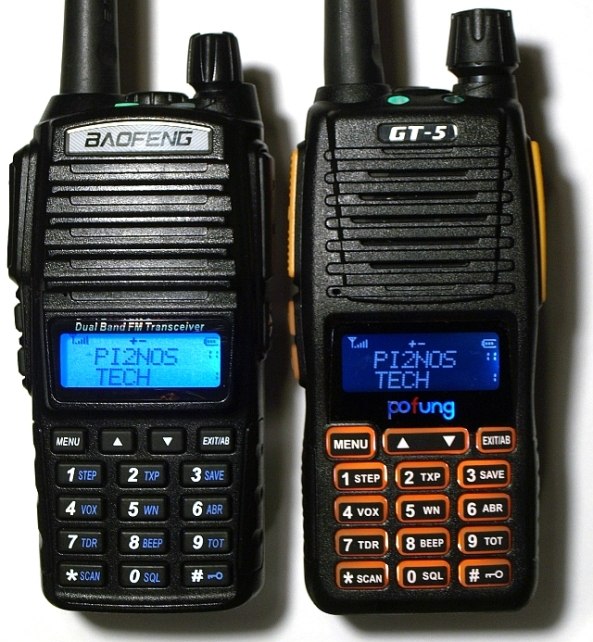

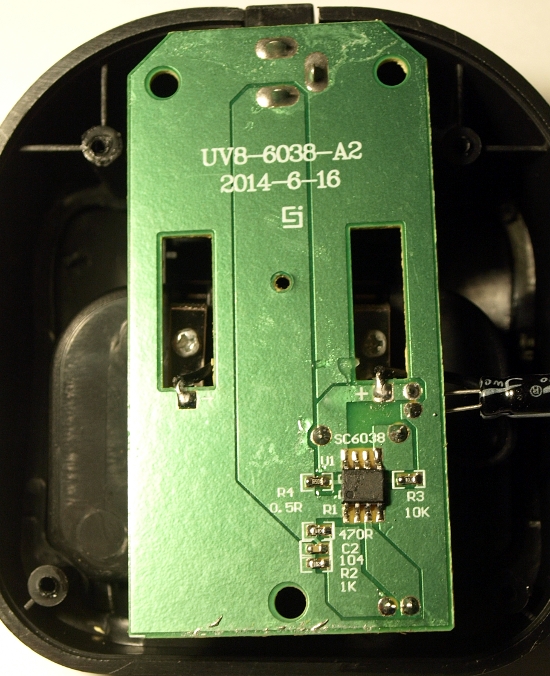
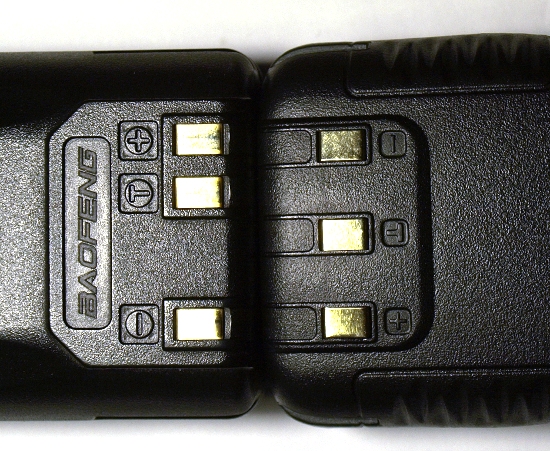
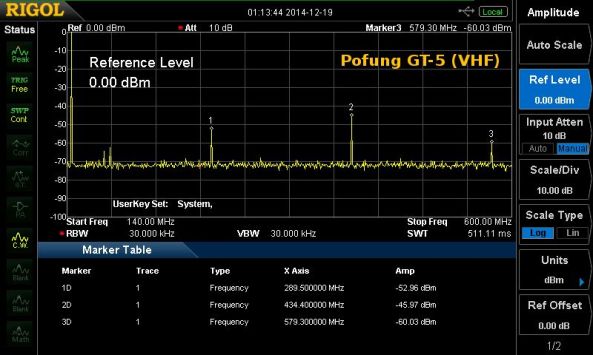
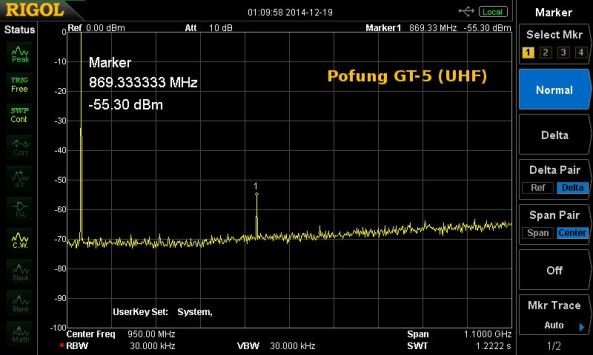
Pingback: Pofung (Baofeng) GT-5 en détail | Radioamateurs-France
£33
http://www.ebay.co.uk/itm/400822742047
for price-comparison, a UV-82 is now £28 on ebay,
and a UV-89 from 409shop is $45 (£30) and comes in bright red or dark green 🙂
Must admit I am a UV-82 fan..
Hans,
If you are claiming that the battery is incompatible because of the different location of the “T” terminal, it may still be compatible. The “T” terminal is not connected in the charger and is therefor not used. I’ve even seen posts on Facebook where some of the newer UV-82 chargers ship without the “T” terminal. So as long as the “-” and “+” terminals line up, it may be OK.
Jim KC9HI
my 82 doesnt even have the T contact on the battery.
Stephen, for what i can see in the photo the contacts on the battery are slightly different positioned in height. I’m not sure how that will work out.
More and more, it seems as if BaoFeng is pushing CHIRP as the preferred programming software rather than developing their own alternatives. That’s great, but I’d also like to think that BaoFeng is *financially supporting* CHIRP development.
It’s taken a lot of free work from the amateur community to make the BaoFeng line viable. You basically provided a practical UV-5R manual for free here on the blog, for example. The one that BaoFeng provided was almost useless.
if Baofeng (or any other company) is using CHIRP to sell products then they should provide documented eeprom memory-maps and serial protocols.
and they should do so before the radio’s go on sale!
BaoFeng is not pushing CHIRP, they have their own proprietary software which they recommend. It’s just that most people prefer CHIRP because it is easier to use.
Baofeng Tech, Baofeng’s preferred US importer/retailer and their sole retailer of the BF-F8HP which likes to give the impression that it is Baofeng that you are dealing with.
https://baofengtech.com/download
Programming BaoFeng Radios CHIRP:
BaoFeng Factory Software (VIP):
We do not recommend using the factory software (VIP) but the following links are provided – Windows Only
Next……..
Yes, but as you said is is NOT BaoFeng, but a third party seller. Nowhere on the official BaoFeng page does it recommend using CHIRP.
Next…
When the GT-3TP review is released? I’m waiting your review to buy that radio.
Hi Sérgio,
not sure… it’s the holiday season, you know. Things normally slow down a bit during Christmas and New Year.
Well i am in the same boat as you are 🙂
Baofeng x Misuta
Anyone done any reading up on the above. Supposed to be new for 2015 and the radios are badged Masuita, but clearly Baofeng and new chips.
On ebay now and gives product details and chipset details at end of auction.
Just looked at those, nice fantasy model names (Hero, Samurai), and still shipped with that short, crappy antenna.
well they are pictured with the crap antenna, but so was the GT-5.
and i’v read on forums of people buying UV5’s recently and getting the newer “U-V” antenna like on the 82.
so i’d say hope for the best, but expect the worst and see what happens!
the Misuta range is the same price as the 5R but has the inverted display, i was tempted to get one.
keep an eye on BF’s new products, i suspect we may see a high-power 8w+ version of the 82 soon, seeing as they have done it to the 5R sries across the range almost.
🙂
it’s soo hard to know what to buy now, a red 82 (UV-89R) or a Misuta, or wait for info on the RST599 – soo hard with so many choices!
Shame its not a real update. Great looking radio. This would be a killer radio if it had the tri-power 8W output, a normal screen and rotary encoder as per the B5.
So it seems the UV82 is still the best bang for the buck when buying radios. Would you recommend the UV82 orvet the UV-B5 now? Also I noticed that the Uv82 are sold as both pofung and baofeng label on Amazon. Just to confirm is there any differences other than the label
I like the UV-82 better than a standard UV-5R. When it comes to receiver quality, the UV-B5 still wins. The Baofeng GT-3 Mark II does even better, which was a bit of a surprise.
Baofeng changed its name to Pofung recently; they’re the same thing.
what are the two buttons at the top left and right of the radio on the back? Small black plastic spring loaded buttons?
These lock the battery into place, just like with the UV-82.
Hans, I am sure you have heard the news – but if not, we have a huge product announcement coming soon! https://www.facebook.com/PofungBaoFeng/posts/909566992421502
Conclusion: GT-3 vs GT-5 ???
GT-3 Mark II because of the updated chip set and better firmware.
Hi Hans!!!
I mean gt-5, 2015. Is this a new model or just “Facelift” ? 🙂
Please check spec…
Thanks for help.
http://www.ebay.de/itm/2015-Pofung-Baofeng-GT-5-VHF-UHF-2m-70cm-Hand-Funkgerat-CTCSS-CDCSS-Upgrade-PMR-/400713138855?pt=DE_Handys_Kommunikation_Funktechnik&hash=item5d4c5d42a7
I’m pretty sure that this is the same radio I reviewed, so it’s basically a UV-82 in another package.